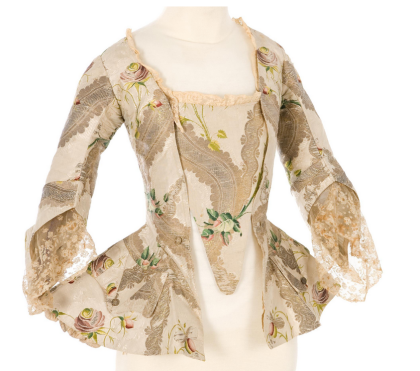 |
| This - rather dark photo - shows how long the caraco could be at the back |
Another version of the caraco was the caraco à la Polonaise which became popular in the 1770's-1780's. Like the French version it took its name from the type of gown which it looked like. The caraco would be tight-fitted around the waist but would flare up at the back. It was different from the caraco à la Polonaise by having a bodice where the lower part curved toward the back.
 |
| Here is the opposite of the one above - looser and with hardly any "tail" |
Usually, the caraco was worn over a petticoat and was considered an informal article of clothing.
The sleeves were either full-length or three-quarters length but were always tightly fitted. This is one type of clothing which was not exclusive to the upper classes since middle class and lower class women were also wearing it - although with less rich materials. As it happens this particular style worked its way up in society since it was common among the lower classes before the aristocracy noted an opportunity for a new trend.
 |
| Dutch version of a caraco from the second half of the 18th century |
In France the caraco would often be open at the front displaying a beautiful bodice while the English preferred to have the jacket sewn completely together.
Some caracos were attached to a hood; these were known as a caraco à coqueluchon. A caraco could be made to match the petticoat underneath but others preferred to have a contrasting colour or pattern.
 |
| A caraco with a matching stomacher |
Over the years the caraco went through an evolution. In the 1740's it was basically a gown which had been cut off at hip-length but forty years later it was tightly fitted at the waist and flared loosely at the wearer's back. The 1780's caraco were not stiffened by whalebone and only a somewhat loose corset was required to wear it. This is quite possibly why Marie Antoinette was fond of it since she detested wearing the tight-laced corsets demanded by French fashion.
 |
| Caraco à la Polonaise, 1780 |
 |
| Caraco à la Francaise with a hood! 1790 |
 |
| Mariana Victoria of Spain wearing a caraco displaying an elaborate bodice |
 |
| Lady Mary Fox following the English tradition of having a closed caraco |

No comments:
Post a Comment